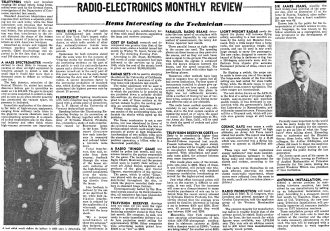|
May 1947 Radio-Craft
 [Table of Contents] [Table of Contents]
Wax nostalgic about and learn from the history of early electronics.
See articles from Radio-Craft,
published 1929 - 1953. All copyrights are hereby acknowledged.
|
For many years in the late 1940s
/ early 1950s, Radio-Craft magazine ran a regular "Radio-Electronics Monthly
Review" feature that reported on industry news items. This May 1947 issue included
such topics as the post-war discovery of German "teletypers" which used a series
of electrical impulses to form the numerals, letters, and symbols by constructing
them using vertical and horizontal lines. Doing so enabled symbols other than a
standard character set to be transmitted and received. It also made the receiver/printer
apparatus more compact since it only needed a few shapes for impressing the image.
Also reported was the fact that radar development cost more overall than the cost
of developing the atom bomb. In some ways that is surprising, in other ways not.
Cosmic rays and "other mysterious energy radiations" were determined to be interfering
with high altitude radio communications. Read on for more interesting tidbits...
Radio-Electronics Monthly Review
 Teletypers which sent impulses
shaping the actual letters being transmitted were used by the German forces, investigators
of the Department of Commerce reported last month. Teletypers which sent impulses
shaping the actual letters being transmitted were used by the German forces, investigators
of the Department of Commerce reported last month.
Standard American teleprinters send impulses that activate a separate printing
key for each letter, while the Nazi instrument sent impulses that formed the vertical
and horizontal lines of actual letters. One advantage of this system was that interference
in the circuit distorted the shape of the letters in words instead of printing the
wrong letters as with American teletypes.
Described as simple and rugged, the German machine weighed only 60 pounds. Chief
disadvantage was reported to be the fact that it can only send 150 characters a
minute.
Cost of Radar research and development was greater than that
of the atomic bomb, states a booklet issued last month by Wesley W. Stout, former
editor of The Saturday Evening Post.
According to Mr. Stout, $2,700,000,000 worth of radar equipment had been delivered
to the services up to July, 1945, while the cost of the atomic bomb is given as
around $2,000,000,000.
Cosmic Rays may cause a radio set to go "completely berserk"
at high long-altitudes, an Army Air Force report stated last month. The report was
based on experiments carried on by a B-29 which was converted into a flying laboratory
to operate at 35,000-foot altitudes.
These rays and "other mysterious energy radiations" may make considerable i modifications
necessary in high-flying radio and radar apparatus for planes and rockets, according
to the report.
(Yet radio waves themselves do not seem affected, otherwise the recent classic
moon-radio experiment, where waves were reflected from the moon to the earth, could
not have taken place. - Editor)
Radio Production will reach a peak late in 1947, R. C. Cosgrove,
vice-president and general manager of the Crosley Corporation, told the appliance
group of the Western Merchandise Mart.
The present capacity for manufacturing radios is roughly double that of the prewar
period, he stated. Radio production for June, the last month for which figures were
available, was 1,378,000 sets. This rate sets an all-time record, but is still lower
than manufacturing capacity would permit.
Posted March 17, 2022
|









